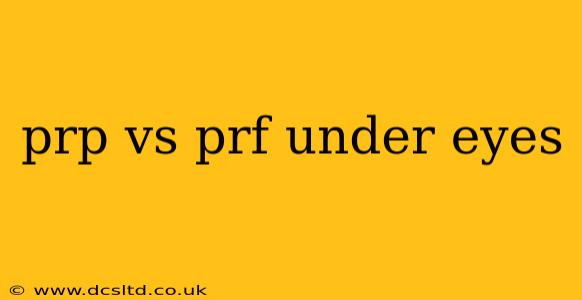The delicate skin under the eyes is prone to showing signs of aging faster than other areas of the face. Dark circles, fine lines, wrinkles, and loss of volume are common concerns. Platelet-rich plasma (PRP) and platelet-rich fibrin (PRF) are two innovative treatments gaining popularity for rejuvenating this sensitive area. But what's the difference, and which one is best for you? Let's delve into the specifics of PRP vs. PRF under eyes to help you make an informed decision.
What is PRP?
PRP, or platelet-rich plasma, is a concentration of your own platelets derived from a small sample of your blood. Platelets are rich in growth factors, proteins that stimulate cell regeneration and tissue repair. In the context of under-eye rejuvenation, PRP injections aim to:
- Reduce dark circles: By improving blood circulation and stimulating collagen production.
- Improve skin texture: By smoothing fine lines and wrinkles.
- Increase skin firmness: By boosting collagen and elastin production.
The process involves drawing a blood sample, centrifuging it to separate the platelets, and then injecting the concentrated PRP into the under-eye area.
What is PRF?
PRF, or platelet-rich fibrin, is similar to PRP but with a key difference. It's also derived from your blood but uses a different centrifugation process that results in a fibrin matrix containing a higher concentration of growth factors and cytokines. This matrix acts as a scaffold, promoting longer-lasting tissue regeneration and remodeling. Compared to PRP, PRF:
- Offers prolonged effects: Due to the fibrin matrix acting as a sustained release system for growth factors.
- May lead to improved collagen stimulation: The fibrin matrix supports cellular activity more effectively.
- Potentially less processing required: The preparation method is simpler and may require less time.
The procedure involves a blood draw, followed by centrifugation and the application of the PRF membrane or injection of the PRF concentrate.
PRP vs. PRF: Key Differences Summarized
| Feature | PRP | PRF |
|---|---|---|
| Growth Factors | High concentration | Even higher concentration and a wider range |
| Fibrin Matrix | Less significant | Significant, acts as a scaffold |
| Duration of Effects | Typically shorter | Typically longer |
| Preparation | More complex centrifugation process | Simpler centrifugation process |
| Cost | Can vary, often comparable to or slightly less than PRF | Often slightly more expensive than PRP |
What are the potential side effects of PRP and PRF under-eye treatments?
Both PRP and PRF are considered minimally invasive, but potential side effects can include:
- Bruising: This is common and usually resolves within a few days.
- Swelling: Mild swelling is also expected and generally subsides quickly.
- Discomfort: Some patients report mild discomfort during or after the injections.
- Infection: Although rare, infection is a possibility with any injection.
It's crucial to choose a qualified and experienced practitioner to minimize the risk of complications.
How long do the results of PRP and PRF under-eye treatments last?
The longevity of results varies depending on individual factors such as age, skin type, lifestyle, and the initial condition of the skin. Generally:
- PRP: Results may last several months, with some patients needing touch-up treatments every 6-12 months.
- PRF: Due to the sustained release of growth factors, results may last longer, potentially up to a year or more in some cases.
Which treatment is right for me – PRP or PRF under eyes?
The choice between PRP and PRF depends on individual needs and preferences. A consultation with a qualified dermatologist or aesthetic specialist is essential to determine the most suitable option. They can assess your skin condition, discuss your goals, and advise you on the best treatment plan. Factors they will consider include:
- Severity of your under-eye concerns: For more significant concerns, PRF might be a more suitable option.
- Your budget: PRF treatments are often slightly more expensive.
- Your desired longevity of results: If you're looking for longer-lasting effects, PRF might be preferable.
Are there any alternatives to PRP and PRF for under-eye rejuvenation?
Yes, several other treatments are available for under-eye rejuvenation, including:
- Fillers: Hyaluronic acid fillers can add volume and reduce the appearance of hollows.
- Laser treatments: Certain lasers can stimulate collagen production and improve skin texture.
- Chemical peels: These can improve skin tone and texture.
Ultimately, choosing between PRP and PRF, or exploring alternative options, requires a personalized approach. A thorough consultation with a medical professional will ensure you receive the most appropriate and effective treatment for your specific needs and goals. Remember to always prioritize a qualified practitioner with experience in these procedures.
